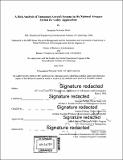| dc.contributor.advisor | Georgia Perakis and Warren Hoburg. | en_US |
| dc.contributor.author | Mohl, Jacquelyn Nowicke | en_US |
| dc.contributor.other | Leaders for Global Operations Program. | en_US |
| dc.date.accessioned | 2016-09-13T19:24:54Z | |
| dc.date.available | 2016-09-13T19:24:54Z | |
| dc.date.copyright | 2016 | en_US |
| dc.date.issued | 2016 | en_US |
| dc.identifier.uri | http://hdl.handle.net/1721.1/104317 | |
| dc.description | Thesis: M.B.A., Massachusetts Institute of Technology, Sloan School of Management, 2016. In conjunction with the Leaders for Global Operations Program at MIT. | en_US |
| dc.description | Thesis: S.M. in Engineering Systems, Massachusetts Institute of Technology, Department of Aeronautics and Astronautics, 2016. In conjunction with the Leaders for Global Operations Program at MIT. | en_US |
| dc.description | Cataloged from PDF version of thesis. | en_US |
| dc.description | Includes bibliographical references (pages 115-121). | en_US |
| dc.description.abstract | A need exists for utility companies to incorporate unmanned aircraft systems (UAS) into their operations to reduce the cost and increase the safety of asset inspections. The FAA is allowing the use of UAS for commercial purposes under strict operational restrictions that would limit utility companies from realizing the full potential of UAS operations. The goal of this thesis is to provide a comprehensive risk analysis for National Grid as well as other utility companies to guide some of the Federal Aviation Administration's (FAA) imposed restrictions to enable wider use of UAS in utility operations. Through a probability-based risk analysis, a level of safety (LOS) was determined for utility applications based upon two major failure modes identified by a hazard tree analysis: midair and ground collisions. The factors considered in the ground collision model include: UAS reliability, wind gust data, population density, time use survey data and the FAA-published LOS for aircraft in the National Airspace (NAS). These factors were combined to determine the minimum UAS mean time between failure (MTBF) required to meet the FAA LOS requirement. The results of this analysis determine that the UAS must have a minimum MTBF of 478 hours to operate within National Grid's service territory. This MTBF measurement varies per town due to differences in wind speed and population density. For the midair collision, the factors considered were helicopter flight patterns near power lines, UAS potential flights patterns, and the reliability of system processes to keep UAS and helicopters out of conflict. For the New England territory, an 88.2% measure of reliability of the system is required to maintain the stated LOS, while New York requires 60.7%. This difference is due to a larger amount of lockout patrols over a smaller overall mileage area in New England. Various mitigation factors can be used to ensure even further safer operation, including geofencing and see-and-avoid systems. Through this risk analysis, National Grid and other utilities have additional data on the safety of operating UAS for their use cases. This analysis will be used as supporting data for Edison Electric Institute's request to the FAA for a beyond visual line of sight pilot study on utility assets. | en_US |
| dc.description.statementofresponsibility | by Jacquelyn Nowicke Mohl. | en_US |
| dc.format.extent | 127 pages | en_US |
| dc.language.iso | eng | en_US |
| dc.publisher | Massachusetts Institute of Technology | en_US |
| dc.rights | M.I.T. theses are protected by copyright. They may be viewed from this source for any purpose, but reproduction or distribution in any format is prohibited without written permission. See provided URL for inquiries about permission. | en_US |
| dc.rights.uri | http://dspace.mit.edu/handle/1721.1/7582 | en_US |
| dc.subject | Sloan School of Management. | en_US |
| dc.subject | Aeronautics and Astronautics. | en_US |
| dc.subject | Leaders for Global Operations Program. | en_US |
| dc.title | A risk analysis of unmanned aircraft systems in the National Airspace system for utility applications | en_US |
| dc.type | Thesis | en_US |
| dc.description.degree | M.B.A. | en_US |
| dc.description.degree | S.M. in Engineering Systems | en_US |
| dc.contributor.department | Leaders for Global Operations Program at MIT | en_US |
| dc.contributor.department | Massachusetts Institute of Technology. Department of Aeronautics and Astronautics | |
| dc.contributor.department | Sloan School of Management | |
| dc.identifier.oclc | 958279150 | en_US |
